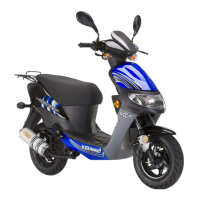17
This is the final, and perhaps most
complicated step in the 2-stroke process.
As the piston travels downward, the
EXHAUST PORT opens. This allows
the combusted gasses to exit the engine.
As the piston continues downward, the
TRANSFER PORT is now exposed.
This allows for the compressed mix in
the crankcase to expand and enter the
cylinder. NOTE: The intake port
remains closed. As the piston reaches
BDC, a new cycle begins.
This cycle of the 2-stroke engine translates into a fundamental rotational force inflicted
upon the crankshaft, known as TORQUE. This force is translated to the vehicle’s drive
wheel via a clutch assembly and drive belt. The metric unit of measurement for
TORQUE is equal to the unit of force multiplied by the length of the arm that inflicts it,
which is the Newton-meter (lb-ft standard).
In order to optimize the efficiency of this engine cycle and maximize TORQUE output,
the timing of ignition of the compressed air-fuel mixture is managed by the vehicle’s
CDI.

